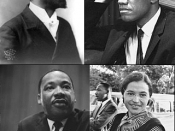* When the Civil Rights Movement is mentioned, assume it refers to the Black Civil Rights Movement
The Rise of the Civil Rights Movement
1940-1965
The History of the African American Civil Rights Movement can be traced back to the arrival of the first Africans onto our soil. Somewhere in our country, there has always been someone who fought for freedom and equality for these oppressed people. However, starting in 1940, and picking up steam after WWII, this movement gained power and became the concern of the American people and government. Many changes were occurring in the social and economic structure of our country, and the Blacks and Black sympathizers justifiably felt left behind. Additionally, many Blacks served our country faithfully in WWII fighting a war for the oppressed people of Europe, yet in their own homeland, the land of the free, they had no rights. Thus, beginning in 1940, the shifting American lifestyle and attitude, as well as economic and demographic upheaval led the government and people of America to believe that the time had come to recognize the cause of the Black people who in turn amplified their efforts to bring themselves freedom and equality among the American people.
Black people in America began to feel the stirrings of desegregation when they were called to enlist in the Army and serve our country in WWII. Though most served in their own units, the Blacks still contributed a large part to the war effort. Truman, horrified by stories of lynching and other atrocities inflicted upon worthy soldiers, had the Integration of Armed Forces Act passed in 1948 outlawing segregation in the armed forces and other federal civil services. Seven years prior, FDR had the Fair Employment Practices Commission set up, but no major desegregation efforts had been made since...


